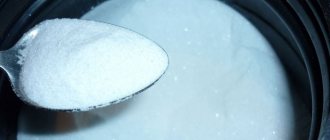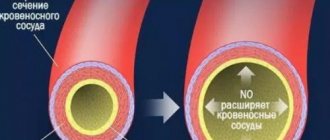Muscle hypertrophy
Despite the fact that many laboratory studies have been conducted with creatine, the study of the beneficial properties of this acid does not stop. After several experiments, the main effect on the organic resource was revealed - increasing the endurance of muscle cells by reducing the glycogen content in them.
Recently, after a series of experiments, it was found that creatine improves the production of a protein of fibrillar structure - myosin. This element, in turn, stands alongside the main components of myofibrils - contractile muscle tissue. These are precisely the fibers that take the main part in performing various types of exercises in iron sports, since they squeeze and pull weights.
The results of the research became sensational in certain circles. Not stopping there, several more analyzes were done. With their help, it was established that in a short period of use creatine acid can have a positive effect on the body of people who are prone to rapid muscle loss.
The natural and first explanation for the increase in muscle mass (hypertrophy) is the fact that creatine is able to flood it. But, as it turned out, in addition to water retention, after a short course of taking the supplement, they found a general expansion of muscle fiber - not only due to an increase in energy sarcoplasm.
To date, it has been successfully proven that creatine slows down the process of protein destruction in the athlete’s body.
How does creatine work?
Creatine is the most popular sports nutrition supplement on the legal market for these products. And for good reason, because it is creatine that provides the athlete with one of the most important processes - energy exchange. This is why the effects of this supplement are so important. Many people wonder: how does creatine work, and what effects can be achieved with it? We will consider these and other important questions about creatine in this article.
What is creatine?
To understand how creatine works, you need to understand what it is. Creatine is a natural substance with the complex name of a nitrogen-containing carboxylic acid. Its main task is to participate in the energy exchange of muscle fibers, thereby giving them strength, endurance and increasing their volume. Creatine is found in a number of different foods, such as beef, cod and flounder. But the amount of the substance that comes from foods, even rich in its content, is still not enough for an athlete. And to get the right amount you need to eat a lot of foods. Therefore, creatine, as a sports supplement, is simply necessary for a bodybuilder. We learned about the substance a long time ago; it was discovered by a French scientist in 1835, but it gained popularity among athletes only at the beginning of the 20th century. Creatine can be considered one of the most studied and safe supplements in sports nutrition and at the same time highly effective.
How does creatine work?
In order for muscles to do their job, namely contract, they need adenosine triphosphate (ATP), which will lose phosphate acid and turn into AF or adenosine diphosphate. But here, too, not everything is so simple, AF cannot produce energy, for this you need creatine phosphate (CP). To obtain CP, which ultimately forms ATP molecules, creatine is needed. The conclusion of this chain is simple: the higher the CF, the more you can work your muscles until fatigue sets in.
With intense training, CP and ATP are very quickly depleted from the body, and along with them energy. Here creatine comes into play again, replenishing the reserves of CP and ATP and allowing the athlete to get more from the training. Of course, you won’t be able to get the required amount of creatine naturally; you need to take it as a sports supplement.
On average, the human body contains about 100-140 grams. creatine In normal life, its consumption is 2-3 grams. per day, but during training, much more creatine is lost and an athlete also needs to replenish its reserves in a larger dose than an ordinary person.
Effects of Creatine
The role of this substance for a bodybuilder is invaluable, since creatine allows you to achieve results many times higher than without its use. The main effects of creatine include: increased strength due to increased phosphocreatine by taking creatine monohydrate, the amount of ATP increases, and thus muscle strength increases; increase in muscle mass. muscle relief due to good muscle hydration; increases the strength and endurance of the athlete; lactic acid buffer;
Myths about creatine
The higher the popularity of a sports supplement, the more rumors it acquires. Creatine is no exception and there are a lot of myths about its harm to human health. Let's dispel some of them.
Myth No. 1. Creatine negatively affects the functioning of the liver and kidneys. Numerous studies in this area have refuted this myth. Even with a long course of taking creatine, it does not affect the functioning of the kidneys and liver. The only category of people who should avoid taking creatine are people with severe kidney failure. In all other cases, creatine will not harm the functioning of the liver or kidneys. Also, studies on this topic have confirmed that taking the supplement does not affect the lipid spectrum of the blood and does not harm the liver, heart and kidneys. Myth No. 2. Creatine affects the functioning of the gastrointestinal tract. Such claims are also unconfirmed; only up to 5% of people may experience minor abdominal discomfort. Typically, this reaction may occur if a large dose of the supplement is taken on an empty stomach. In all other cases, creatine does not affect the functions of the gastrointestinal tract. Myth No. 3: The supplement leads to dehydration and cramps. This is a fairly common misconception that is not at all supported by facts. Quite the opposite, creatine increases the level of water in the body and thereby maintains normal hydration. Further, one study found that creatine improves performance in hot, humid environments. Myth #4 : Can cause rhambodomyolism. Such information appeared after the New York Times published a note that the national football team had developed rhabdomyolism. This is a disease that results in the breakdown of skeletal muscles. When they began to look into this issue, it turned out that the athletes trained for several days in hot and humid conditions, but there was no talk of taking creatine.
Moreover, it is a proven fact that creatine, on the contrary, can prevent the development of pathology, as it retains water and lowers body temperature.
FAQ
Before starting to take any drug, you want to have as complete an understanding as possible about it. That's why we decided to answer the most frequently asked questions about creatine:
- Does creatine have side effects? This supplement is completely natural, therefore, using it in accordance with the instructions and not exceeding the dose, there are no side effects;
- can I drink coffee if I take creatine? Regarding this issue, an experiment was conducted in Belgium. Where two groups were created: one took only creatine, and the second group took creatine and caffeine. As a result of the study, it was concluded that strength indicators increased in the caffeine-free group. That is, coffee reduces the effect of creatine;
- Can I take creatine on an empty stomach? On the one hand, an empty stomach speeds up the absorption of the supplement, but on the other hand, it can cause pain in the stomach. Therefore, it is recommended to take it with sweet tea or juice;
- what type of additive is most common? Among all types of creatine, creatine monohydrate is considered the most common and in demand. It is the most affordable and reliable type of creatine. Available primarily in powder form;
- how to use? There are two methods with and without loading. The first loading option involves taking the supplement 5-7 grams 4 times a day for a week, then the dose is reduced to 10 grams per day and taken for another 20-25 days. The non-loading option is designed to take up to five grams of the substance per day for a month. Both forms of administration have a positive effect on muscle growth.
Creatine is a universal sports supplement, and most importantly, it is natural and does not cause side effects. In our article, we tried to analyze the main aspects of how creatine works and what effects it has. With proper nutrition, training and taking creatine, you can achieve muscle growth, increase strength and endurance.
Increased IGF-1 activity
IGF-1 (will stand for Insulin-like growth factor 1) is a biologically active nutrient that has an anabolic effect and is a transmitter for the effects of the hormone somatropin. It is synthesized only in the liver and in the muscles themselves. In addition, it further promotes muscle hyperplasia due to an active surge in myosatellites.
After some failed experiments on animals, it was decided to put one on humans. It was this study that made it clear that creatine increases IGF-1 activity. On average, in athletes who take creatine, it increases by 30%. It would seem that such an effect from creatine is expected by an athlete after taking the supplement on a training day, and on days without strength loads it is useless. True, but half. On days without training, IRF-1 activity remains at the same level. But creatine intake must be consumed regularly to maintain its levels in the body.
From general observations of athletes taking such a supplement, it was noticed that a special “surge” in muscle mass growth is observed in the final days of the monthly course.
why do you need creatine in sports
Many people are afraid to take supplements made in a laboratory through chemical reactions. But should creatine be taken into the body only from food?
A study was published in the journal Molecular and Cellular Biochemistry by Richard Kreider and co-authors. It states that athletes should consume a minimum of 5 to 10 grams of creatine per day to adequately maintain muscle stores.
It is not possible to obtain such an amount of the substance from food, so sports nutrition acts as an additional source of creatine.
Creatine prevents age-related muscle loss
Age-related muscle loss is quite common among athletes over 40 years of age. Such a malfunction not only violates the aesthetics of the body, but also contributes to the development of bone fragility and general weakness. This occurs due to a decrease in the main sex hormone - testosterone. In turn, this helps reduce creatine production. This situation promotes muscle loss. As a result, whether you like it or not, a person’s quality of active life decreases.
It can be assumed that supplying the body from other sources coupled with strength loads will be able to stop the death of muscle cells. In addition, everything will happen the other way around, muscle mass will begin to increase.
Creatine can be taken at any age. The supplement has no age-related contraindications.
More about creatine (what it is, facts, action)
Since the end of the twentieth century, there has been no more popular product in the sports nutrition range than creatine. Athletes from all over the planet regularly use creatine as a supplement to improve performance and achieve faster athletic results. The beneficial properties of creatine include: accelerated muscle recovery, increased strength, intense muscle growth.
Description Creatine is a natural amino acid that is formed in the human body from 3 others - glycine, arginine and methionine. Creatine synthesis processes occur in the kidneys, liver cells and hormonal glands.
The vast majority of all creatine (more than 95%) is found inside muscle cells. The use of this substance makes it much easier for athletes to maintain energy balance and eliminate muscle fatigue after active and long-term training.
Historical data Creatine was discovered in 1832 by the French researcher Chevrel, who discovered this amino acid in meat “juice”. From the first years after its discovery, creatine was a fairly important element for building skeletal muscles; it aroused open interest among the scientific community. After some time, Pettenkofer and Heinz identified a substance in the urine that was called “creatinine” - they suggested that such a compound is synthesized from creatine contained in muscles.
At the beginning of the twentieth century, scientists conducted a number of serious scientific experiments that indicated that the use of creatine as a dietary supplement helps to increase its content inside muscle cells in the human body. It was further discovered that creatine retains nitrogen in the human body, thereby promoting intense muscle growth.
Specialized surveys conducted by several manufacturers of health food products indicated that 3 famous Olympic medalists were able to achieve such excellent physical shape and realize their advantage in practice thanks to creatine.
Action In the human body, the basic energy complex is called ATP. While the muscle fibers are under tension, doing a variety of work, ATP releases energy, turning into the ADP state. In this case, the accumulated amount of ATP is sufficient for only 15 seconds of intense exercise, after which the main reserves are replenished thanks to creatine. Such a chemical process is absolutely natural, cyclical and continuous in its specificity.
By consuming creatine, you cannot increase strength and endurance, or gain lean muscle mass. The process of water entering muscle fibers in parallel with creatine contributes to their gradual increase in volume - muscle tissue begins to thicken as protein is deposited on the walls. Compared to steroid drugs, during the use of creatine, water is transported inside the muscles, and not between them - for this reason, anabolic processes inside muscle cells are much better and faster.
How to use? Our body constantly synthesizes approximately 100-140 grams of natural creatine, which serves as the basic energy source for the full functioning of muscle cells. The daily consumption of this substance is within 2 grams. A lack of creatine within the body can lead to a variety of physiological and muscle problems.
Creatine use plan: 1st week of the supplement should be taken 4-6 grams twice a day; 2nd week and beyond - 3 grams twice a day. The course of using creatine is 4-6 weeks; after this time period, professionals advise taking a break, which is necessary to restore the processes of natural creatine production within the body. The break should be approximately 3 weeks.
Time of use The optimal time for the absorption process of creatine is considered to be the period when insulin levels in the blood reach their peak value - after eating sweets, immediately after waking up and 60 minutes after active strength training.
Taking a serving of creatine on an empty stomach will promote more efficient absorption. If you experience unpleasant pain in the abdomen or diarrhea, it is better to take creatine after meals.
Side Effects Most people who regularly use creatine do not experience any discomfort or side effects. However, if any specific symptoms occur, stop using this drug immediately.
Creatine and muscle mass It is worth noting that the isolated use of creatine is not enough to obtain results: muscle tissue will grow only in the case of regular physical activity, which is constantly becoming more difficult, preventing the body from fully adapting. Anyone who wants to increase muscle mass should understand that muscles will progress only under the influence of high sports loads. This effect can be achieved in 3 ways: • increasing the intensity of training; • increasing the duration of classes; • increasing frequencies.
Glycogen preservation
Glycogen is a glycan, the basis of which is glucose residues in the body. Simply put, it is one of the main sources of energy for an athlete's muscle cells. The only disadvantage of glycogen is that its supply is limited, and it is depleted relatively quickly during training.
Previously, only theory and guesswork stated that supplements containing creatine significantly slow down the depletion of glycogen reserves (depending on the amount of creatine in the composition). Now this assumption has been confirmed by science. Thus, it was established as a result of Brazilian studies and experiments: creatine plays the role of an additional supplier of energy units to the body. The process of inhibiting glycogen loss occurs in both muscles and liver.
This effect is great for athletes who are looking to push the limits of their endurance. It is because of this that creatine is recommended to be used not only by bodybuilders, but also by football players, runners, wrestlers, fighters, crossfitters, basketball players and representatives of other sports where aerobic exercise occurs.
As for bodybuilding, everything is a little more complicated. There are stages of bodybuilder training in which the end result is the complete depletion of glycogen from its reserves. In this case, creatine is excluded from the supplement complex.
Creatine and insulin
Any experienced bodybuilder knows many ways to dilute a creatine supplement to enhance its performance. Eg:
- dilution with grape or cherry juice;
- juice with high insulin levels.
The main goal of such creatine dilution regimens is to deliver the maximum possible amount of insulin into the blood. Everything seems simple, but not everything simple turns out to be brilliant. This is where the error lies.
The whole point is that creatine has a hidden property that not everyone knows about - partial blocking of insulin entering the circulatory system. And he does this, believe me, “conscientiously.” Here is the conclusion: there will always be not enough insulin to eliminate creatine in the blood. The only trick that can work in this situation is to use insulin injections 30 minutes before taking the next portion of creatine.
By the way, insulin is a peptide hormone that is involved in all kinds of metabolism in the human body. Its main advantages for an athlete are:
- suppression of blood glucose levels;
- anabolic effect (increases protein synthesis, production of fatty acids, etc.);
- anti-catabolic effect (slows down the breakdown of proteins, blocks the release of fatty acids into the blood).
Creatinine and creatine: what is the difference
Creatine is involved in the processes of energy metabolism and protein synthesis, but is not part of its structural composition. Creatinine is the end product of the creatine phosphate chemical reaction, which provides the body with natural energy.
It is formed as a result of the breakdown of creatine in the body. The concentration of creatinine in the blood depends on the rate of its formation (the state of muscle mass) and the characteristics of excretion by the kidneys. Also, creatinine levels can be affected by gender, weight, dietary habits, and the presence of inflammatory processes in the athlete’s body.
Elevated creatinine levels may be a marker that indicates kidney failure.









